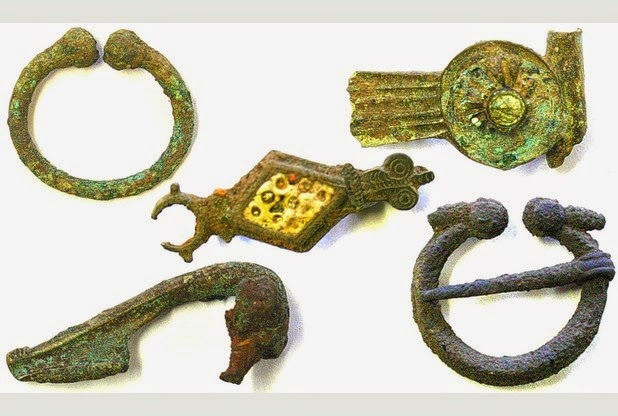A pair of 2,000-year-old tweezers has been found during an archaeological dig at a Roman villa in Leicester. The centuries-old artefact was part of a haul of buried treasures, including copper brooches, medieval coins, ceramics and pottery found last week in Blackfriars.
The tweezers are believed to date back as far as the first century AD and would have been used to pluck stray hairs from the brows of Roman ladies – and possibly men, according to Philip Briggs, of Wardle Armstrong Archaeology, which carried out the dig.
Iron Age, medieval and Roman items have been uncovered during the excavation.
Work started in January and has just finished.
Philip said: "The tweezers are copper and copper alloy. It was common for such tweezers to be part of a toiletry implements set.
"Often they would be used for beauty-related situations, sometimes more practical functions.
"They are usually associated with female owners, but they have been discovered in male, as well as female, graves in the past."
Archaeologists uncovered the pieces ahead of a students flats development at the site.
Leicester City Council archaeologist Chris Wardle said the excavation had revealed the settlement would have been one of the most significant sites in Iron Age Corieltauvi – which covered most of the East Midlands.
He said: "It had been realized for some time that Leicester began to emerge as an important tribal centre before the arrival of the Roman legions in the mid-first century AD.
"The findings on the site add considerably to this picture."
In April, the team of 15 archaeologists also found ceramic tiles and coin moulds.
The coin moulds help confirm the site was home to a 2,000-year-old mint which experts believe created part of the Hallaton Treasure.
The 5,000 silver and gold coins were found in 2000, near the Leicestershire village of Hallaton, the largest haul of gold and silver found in the UK.
Mr Wardle said: "One of the more pleasing aspects of the dig has been the discovery of the Roman bricks and tiles bearing the imprint of animal hooves and paws.
"These are glimpses of fleeting moments that took place many centuries ago, when animals wandered across the site where the bricks and tiles had been laid-out to dry in the sun.
"This was after the bricks had been formed, but before they had been fired in a kiln. Firing the bricks preserved these fleeting moments for the archaeologists to unearth centuries later.
"However, the place where the bricks and tiles were laid out all that time ago may have been tens or hundreds of metres away from the site excavated."
All of the pieces have been sent away for dating and analysis.
Iron Age, medieval and Roman items have been uncovered during the excavation.
Work started in January and has just finished.
Philip said: "The tweezers are copper and copper alloy. It was common for such tweezers to be part of a toiletry implements set.
"Often they would be used for beauty-related situations, sometimes more practical functions.
"They are usually associated with female owners, but they have been discovered in male, as well as female, graves in the past."
Archaeologists uncovered the pieces ahead of a students flats development at the site.
Leicester City Council archaeologist Chris Wardle said the excavation had revealed the settlement would have been one of the most significant sites in Iron Age Corieltauvi – which covered most of the East Midlands.
He said: "It had been realized for some time that Leicester began to emerge as an important tribal centre before the arrival of the Roman legions in the mid-first century AD.
"The findings on the site add considerably to this picture."
In April, the team of 15 archaeologists also found ceramic tiles and coin moulds.
The coin moulds help confirm the site was home to a 2,000-year-old mint which experts believe created part of the Hallaton Treasure.
The 5,000 silver and gold coins were found in 2000, near the Leicestershire village of Hallaton, the largest haul of gold and silver found in the UK.
Mr Wardle said: "One of the more pleasing aspects of the dig has been the discovery of the Roman bricks and tiles bearing the imprint of animal hooves and paws.
"These are glimpses of fleeting moments that took place many centuries ago, when animals wandered across the site where the bricks and tiles had been laid-out to dry in the sun.
"This was after the bricks had been formed, but before they had been fired in a kiln. Firing the bricks preserved these fleeting moments for the archaeologists to unearth centuries later.
"However, the place where the bricks and tiles were laid out all that time ago may have been tens or hundreds of metres away from the site excavated."
All of the pieces have been sent away for dating and analysis.

No comments:
Post a Comment